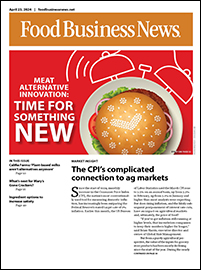KANSAS CITY — Consumers eat with their eyes first. Including eye-catching bits, chunks and pieces in baked goods can lure those consumers to choose one product over another when shopping the aisles, in-store bakery or foodservice establishment. All those extras, however, impact the production process, shelf life and, of course, costs. Because not all inclusions are created equally, with some doing a better job of layering in flavor and visual appeal than others, it’s important for bakers to shop around to get the best bang for their buck.
“There are a lot of considerations of what consumers are treasure hunting for,” said John Namy, vice president of culinary innovation and applications, IRCA Group Americas. “It could be crispy, crunchy, chewy and gooey, or bigger, better, bolder flavors.”
Hardee’s knows the power of inclusions. The quick-service restaurant chain added blueberry biscuits to its summer menu this year. These biscuits contain specks of blueberry bits throughout and are topped with a drizzle of icing. A few years ago, the company offered a different version with a spoonful of blueberry pie filling-style fruit atop the iced biscuit rather than inclusions. The new version — with the blueberry bits included in the biscuit — is much more portable and creates less mess for both the operator and the consumer.
Inclusions offer a plethora of options when it comes to consumers’ sensory experience of baked goods but adding them cannot be at the expense of the whole product’s integrity.
“Our goal as bakers is to maintain the existing structure or system without drastic changes in density, rheology, texture or hydration,” said Catalina Abarca, research and development manager, fruit, creams and decors, Puratos.
Factors to consider
Before adding any extras to baked goods, the formulator should set a budget and work within those financial parameters. Next, consider a number of performance factors. This includes everything from color bleeding to moisture migration to physical breakdown.
“The most important consideration is that inclusions should complement and not have a negative effect on the final baked product,” said Laurie Colin, senior technical business development manager, Blue Diamond Growers. “Inclusions should withstand or tolerate every step of the baking process, including mixing, fermentation or proofing (bread), moulding/machining/depositing, baking and shelf life.”
The inclusions should also preserve their desired appearance, taste and texture when the product is consumed. For example, when adding sprinkles to a moist muffin or cake for a confetti effect, the colors should remain intact and not bleed into the batter.
“It’s also important to identify the type of claim or your goals for the end product early on in the process,” said Mathias Bohn, senior product and strategy manager, flavors, North America, Sensient Flavors & Extracts. “From there, review what processing the product will go through and determine the opportunities and stages when it would be possible to add these additional ingredients, such as the start of blending, the end of blending, prior to baking and so on.”
Inclusion size is another consideration. It’s often dependent on the application and desired impact.
“Smaller particulates can be used at lower inclusion rates but will still provide good visual impact as they disperse throughout the batter more easily,” said Hannah Scolaro, confectionery applications supervisor, Cargill. “Large inclusions, on the other hand, provide a higher flavor impact to your end product and give a more indulgent appearance. The size and weight of inclusions must also be balanced with the density of your batter, so they don’t sink to the bottom of your application during mixing or baking.”
Chocolate comes with its own challenges, particularly in the oven.
“When baking with chocolate inclusions, there’s always the potential of burning the chocolate, particularly when the inclusions are placed on top of baked goods,” Scolaro said. “To minimize this, it’s best to add the inclusions on top toward the end of the bake cycle, limiting the amount of time the exposed chocolate is in the heat of the oven. This isn’t a concern with chocolate pieces that have been mixed in with a dough or batter, as the dough or batter helps to slow the temperature rise surrounding the chocolate, keeping it cooler than the oven’s setting.”
Fat oxidation may be an issue with inclusions that contain a large amount of unsaturated fatty acids, such as those based on nuts and seeds. While these inclusions provide a better-for-you halo to baked goods, they can be challenging to work with if proper steps are not taken.
“They are susceptible to oxidation and thereby becoming rancid due to high-baking temperature and storage during the shelf life of the product,” Colin said. “Nuts also should remain crunchy. A glaze coating can help protect them from air exposure, thereby extending their shelf life.”
Temperature, not only during baking but also during mixing, must be considered. Higher temperatures from the friction of the agitator tool can accelerate oxidation if protective measures are not in place and break down some inclusions. Inclusions may even burn, especially if they are near the surface.
“If the batter is too hot, inclusions like chips may start melting prematurely,” said Shaelyn Corbett, national accounts manager, Parker Food Group. “If a muffin batter is mixed and then sits in the hopper for a bit of time before being deposited into tins, you can see color bleeding off of the inclusion into the batter.”
If a baker is looking for a swirled appearance like a rainbow, piece integrity is important. There are some ingredient strategies to avoid any breakdown or other quality issues.
“If this is not a wanted attribute, you can use fat-coated inclusions,” Corbett said. “A layer of a palm oil or coconut oil over the inclusion bit will help prevent migration from the piece into the batter. This coating also prevents moisture absorption from the remaining food matrix, maintaining texture and preventing sogginess.”
One might think moisture migration should not be an issue with solid inclusions such as chocolate or compounds, but they are.
“These inclusions can be used interchangeably in any baked application,” said Kerry Groves, senior research and development manager, chocolate and compound, Puratos. “They also can succumb to moisture migration when they are exposed on the surface or packaged when warm. Chocolate and compound will absorb water from condensation if packed when they are too warm, which can cause a reaction of sugar bloom, in which sugar migrates to the surface and causes a white, streaky appearance.”
Managing moisture is important for other reasons, too. So is the overall usage rate of inclusions.
“If the inclusion will be competing for water, it can lead to problems of proper hydration for the gluten network or lead to other textural problems,” said Steve Adolphson, senior research manager, Glanbia Nutritionals. “Other factors are how the inclusions will impact the rise and also the texture of the baked good.”
Too many inclusions may weigh the batter or dough down. Bakers should make sure the base is strong enough to withstand the addition of the inclusions. Bakers must also avoid allowing the inclusions to negatively interact with the base batter or dough.
“Batters are typically flowable and pourable,” said Kami Smith, director of culinary showcasing, Pecan Deluxe. “If adding fresh berries, orange juice or even a strawberry paste, the baker can cause havoc if not aware of how that batter emulsion can get abused. What we prefer to do is look at the batter formula and figure out the percentage of water or the main liquid and ‘back in’ to the formula with the necessary flavors and liquids. Then the inclusions can be added as a way to form texture, experience and drive home the flavor profile as intended. Baking isn’t for the weak. It does take critical thought and approach while caring for the perfect balance of function, flavor and friction.”
Exploring new options
In general, when exploring inclusions, bakers should consider ingredient integrity, nutritional value and label simplicity. Many bakeries have started to prioritize clean label ingredients with no added sugars or preservatives, aligning with consumer demands for transparency. Another consideration is versatility.
“Select inclusions that can be used in various applications, ensuring consistent performance across different baked goods,” said Heidi Clark, national sales and marketing manager, MicroDried. “By focusing on these criteria, bakers can enhance the quality, appeal and nutritional profile of their products.”
“Free-from” claims for inclusions may be used in clean label and allergen-friendly products. Free-from added sugars is also trending.
“Sugar reduction continues to be a trend, with consumers looking for natural sweeteners to reduce or completely cut added sugar,” said Thom King, chief innovations officer, Icon Foods.
While eliminating or reducing sugar via inclusions is gaining momentum so is using inclusions to add nutrition. Whole nuts, fruits and vegetables can assist. These ingredients can be enrobed or glazed for an extra layer of flavor and indulgence. Enrobing also helps keep these fragile inclusions intact.
Using fresh fruit or high-moisture fruits — think pie filling — has limitations in many baked goods. That’s why bakers often rely on dried whole fruits — or even vegetables for savory baked goods — or bits and pieces infused with the real deal.
“Use of real fruit pieces allows bakers to make natural flavor and fruit content claims,” said April Thiel, vice president of sales at Parker Food Group. “You can also add the real fruit pieces with other inclusions for flavor adventure.”
These pieces can be coated in a yogurt compound, adding creamy texture and tangy flavor. The coating can be formulated to contain protein to boost the nutritional profile.
“They are great for breakfast bars, muffins and granola,” Thiel said. “They do require careful storage to prevent the coating from melting or becoming sticky.”
In the fruit inclusion sector, the emphasis on “made with real fruit” and “free from artificial flavors and colors” is paramount. Insights from Puratos’ global research platform, Taste Tomorrow, indicate that these trends are not only here to stay but will also continue to evolve.
Dried whole fruit and vegetable pieces and fragments add color, flavor, texture and nutrition to baked goods, usually without contributing to the added sugar declaration. Mango pieces, for example, add a tropical flair to pastries and bars, while strawberry slices provide a sweet, fruity note to cakes and scones.
“What sets these inclusions apart is their intact cell structure, which ensures piece identity and delivers more pieces per pound than traditional dried fruits,” Clark said. “This enables them to maintain superior flavor and color throughout the baking process.”
Fruit inclusions can encounter a wide range of issues, however, especially around their moisture content. Fruit d’Or developed its No Bleed, Extra Juicy Wild Blueberries to address these issues. Jonathan Khouzam, senior R&D specialist, product applications, Fruit d’Or, explained that the blueberry is dried to a higher moisture level than conventionally dried wild blueberries with a gentler process.
“Under these conditions, the fruit maintains its shape and flavor,” he said.
When a whole fruit claim is not necessary, naturally fruit-flavored inclusions provide an economical and versatile option. They allow for flavor fusions all in one bit.
“I like to combine the fruit morsels with natural cream cheese morsels or chocolate morsels,” Namy said.
Consumers may eat with their eyes first, but taste is paramount. In baked goods, texture is almost as important.
“Texture in bakery goods is a true romantic story,” Smith said. “Core memories are created by the first bite of many silken pies, soft cookies and even freshly sliced bread at your local casual dining restaurant. An inclusion doesn’t have to be a large piece or even noticeable. In fact, small can be large in this area.”
It’s all about choosing the right inclusions and effectively adding them. It’s about making the consumer go “wow.”




